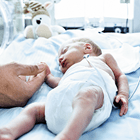Printed from acutecaretesting.org
October 2010
Oxygen monitoring in premature neonates
Summarized from The SUPPORT study group. Target Ranges of Oxygen saturation in Extremely Preterm
Most babies born prematurely have respiratory problems and require assisted ventilation and oxygen therapy to ensure adequate tissue oxygenation. Supplemental oxygen is a double-edged sword for these babies because although of life-preserving benefit, oxygen in excess is toxic.
The principal (but not the only) complication of excessive oxygen for these premature babies is increased risk of retinopathy, a condition that can progress to permanent blindness. Careful monitoring of blood oxygen is therefore required to ensure that sufficient oxygen is being delivered for adequate tissue oxygenation whilst minimizing the risk of retinopathy.
Measurement of arterial pO2 is the gold-standard method for monitoring blood oxygenation but continuous measurement of % oxygen saturation by pulse oximetry (SpO2) has in recent years proved a convenient and reliable alternative.
There is broad agreement that SpO2 should be maintained within the wide range of 80-95 % among neonates, but controversy over whether maintaining SpO2 at the lower end of this range, rather than the high end, reduces the risk of retinopathy. Recently published research addresses this issue. A total of 1316 newborns (gestational age 24-28 weeks) were randomly assigned at birth to one of two SpO2 target-range groups.
The target range for the first group was 85-89 % and for the second, 91-95 %. Severe retinopathy occurred in 8.9 % of survivors in the first group but in 17.9 % of those in the second group.
Although these data indicate clear benefit of a lower target SpO2 in terms of retinopathy risk (relative risk 0.55), the lower target was associated with slightly increased mortality (19.9 % versus 16.2 %; relative risk 1.27). In summary the study has demonstrated that among extremely premature infants, lower oxygen saturation significantly reduces the incidence of severe retinopathy but may increase the risk of death.
May contain information that is not supported by performance and intended use claims of Radiometer's products. See also Legal info.







